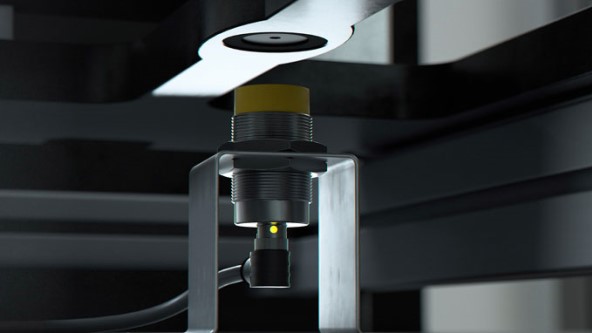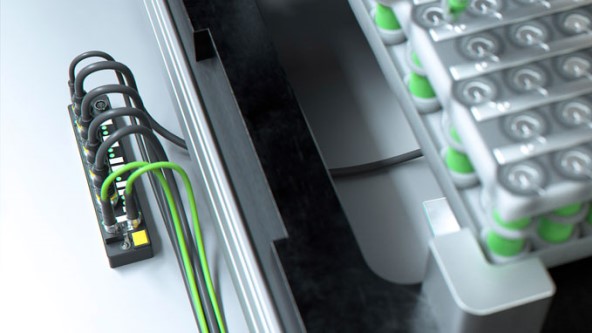RFID Bus Mode Ensures Quality of Lithium-Ion Batteries
Bus mode combines a high data transfer rate with a low cost per read position
With the current boom in the NEV (new energy vehicle) market, demand for lithium-ion batteries is rising. The level of automation in battery production has a direct impact on the quality of the batteries. Manufacturers use RFID technology to monitor production and to document quality tests.
The quality of every weld spot is checked
When assembling battery modules from individual cells, the cells are welded to an aluminum strip that connects them together. The quality of the weld spots is vital to ensuring the quality of the finished battery. Therefore, the entire module is tested after welding. The result of the test is written directly in the tag located under the product carrier of the module. The production line includes around 35 read/write positions in total.
Your Benefits
- High product quality ensured by reliable test documentation
- Cost-effective production thanks to RFID HF bus mode
- Multiprotocol functionality for easy integration into different Systems
- Short read/write times for high productivity
With so many read/write heads, using standard RFID systems can become expensive. RFID via IO-Link is frequently used as an alternative, but is often too slow due to the low bandwidth.
Low price per read/write position with HF bus mode
We recommend using Turck's HF bus mode. Up to 32 read/write devices can be connected in series to a single interface RFID port, effectively reducing the price per read/write position. The production line can maintain its original speed because bus operations offer a relatively high bandwidth. Another advantage is that every read/write head can read both EPROM and FRAM tags, which are both used on these production lines.
Inductive sensor triggers read/write head
Tag reading is triggered by an inductive sensor. If multiple tags are present in the air interface of different read/write heads simultaneously, the PLC creates a buffer to execute the commands at the different read/write heads one after the other. The trigger sensor also helps to detect errors: if the read/write head cannot read a tag after it has been triggered by the sensor, this indicates that the tag is faulty.
TBEN-S connects triggers and read/write devices
RFID devices and trigger sensors are connected directly to the TBEN-S2-2RFID-4DXP. The IP67 interface communicates with the PLC via PROFINET. As a multiprotocol device, it can also be used seamlessly in Ethernet/IP or Modbus TCP networks without requiring any user intervention.
- Automotiva
- Inductive Couplers Ensure Precise Material Feed
- Gestão de montagem com uma conexão MES direta
- Detecção de veículos na Produção Automobilística
- Reliable Skid Detection in Automotive Production
- Eliminação de falhas na identificação de para-choques
- RFID Bus Mode Ensures Quality of Lithium-Ion Batteries
- Level Measurement in Dip Coating Line
- Controle de nível no sistema de lubrificação central
- Qualidade da operação do robô na instalação de para-brisas
- Tilt angle sensor accelerates platform alignment
- Controle e Monitoramento de condições em Motores
- Sinais de segurança dos processos do módulo IP67 híbrido
- Monitoramento descentralizado de estações de refrigeração com RFID
- Células robóticas para solda em Rede Ethernet
- Monitorando o circuito de resfriamento em equipamentos de soldagem
- Monitoramento de fluxo em lavagem de peças automotivas
- Monitoramento de Condição de Motores como Retrofit
- Monitoramento do lubrificante de refrigeração em CNC
- Prensas de metal com identificação da ferramenta
- Detecção de porcas de solda
- Identificação de Skid
- Montagem Final
- Verificação sem contato para pallets transportadores
- Detecção de nível de itens com RFID UHF
- Monitoramento do lubrificante de refrigeração em máquinas
- Controle de pressão hidráulica em prensas
- Medição da pressão de processo nos elevadores
- Histórias de sucesso
- Planta Modular para Produção Flexível e Eficiente
- Laser Sensor Detects Black Bumpers in Assembly Cell
- Tecnologia de segurança descentralizada para produção modular
- Sistema de transporte modular
- RFID e Módulos I/O para mudanças seguras na ferramenta
- Guias RFID para AGV em produção de suspensão
- IO-Link na produção de Escapamentos
- Identificação do carregador da peça na produção de Ventilação Traseira para BMW
- Detecção de porca para solda
- Rastreabilidade RFID
- RFID na produção de motores
- Produção de Para-choques com Identificação
- Soluções para Linhas de Pintura
- Sensores de Soldagem e Montagem
- Sensores de Ângulo para sistemas de montagem
- Identificação de Ferramenta
- Identificação RFID em Bicos Injetores
- RFID em montagem de carrocerias
- IO-Link facilita a produção de engrenagens de transmissão
- Química
- Sistema de I/O excom permite liquefação segura de hidrogênio
- Decentralized Automation in Ex Areas
- Controle RFID para conexões de tubos em áreas Ex
- Ethernet para economizar espaço na Sala de Instrumentação e Controle
- Automação baseada em Ethernet para Skids Modulares em Áreas Ex
- Interface Ex em plantas de processos modulares
- Detecção de Pigs
- Sinal Remoto de I/O
- Fácil conexão com dispositivos de campo
- Processamento de Sinais com Sistema I/O no Painel de Controle
- Separação de sinal com tecnologia de interface no painel de controle
- Identificação de Conexões de Mangueira
- Monitoramento Eficiente de Condições de Painéis
- Monitoramento de abertura de válvulas com atuadores
- Planejamento e Montagem de Soluções de Sistema
- Histórias de Sucesso
- Efficient Cooling of Industrial Furnaces with Turck's FS+ Flow Sensors
- Sistema I/O Excom cria espaço em salas de I&C
- RFID para Zona 2 e 22
- Controle de Testes Eficiente
- Comunicação de campo intrinsecamente segura
- Parceria para Sistema de controle de Processo
- I/O Remoto para área classificada
- Sensoriamento da Posição de Válvulas
- Flexibilidade com Fieldbus
- Gestão de Ativos com I/O Remoto
- Posicionamento correto com RFID na produção de carboneto
- Conversão rápida em espaço restrito
- Energia
- Alimentícia
- Sensor de monitoramento de condição automatiza o controle climático
- Monitoramento de Condições em Painéis de Controle
- Monitoramento de Condição em Armazéns
- Controle de espessuras de massas em Máquinas de Enrolamentos
- Identificação de recipientes para alimentos
- Verificando Recipientes
- Detector de posição de válvula
- Detecção em Tubos Angulares
- Identificação de moldes de chocolate
- Histórias de Sucesso
- RFID Support Enables Track and Trace in Food Production
- Grist for the Mill
- Controle descentralizado de módulos em câmara frigorífica
- Rastreamento com RFID na produção de carne
- Encoder sem contato no processamento de batatas
- UHF RFID no Centro de Distribuição de Alimentos
- RFID para produção de chocolate
- I/O Distribuído para Equipamentos Alimentícios
- I/O Remota para Destilaria
- RFID e Autoclaves
- Transparência na fabricação do chocolate
- Fontes de alimentação IP67 para transportadores
- Identificação no Armazenamento de Produtos Alimentícios
- Intralogística
- Controle Descentralizado de Módulos de Esteiras
- Tracking Big Bags with RFID
- Distance Detection in Container Cranes
- Controle de acesso em áreas protegidas
- Muting descentralizado de equipamentos de proteção eletro sensíveis
- Módulos de I/O controlam esteiras transportadoras
- Detecção Rápida de tags nos Portões do Armazém
- Item-level Detection with UHF RFID
- Manutenção preventiva em correias transportadoras
- Detection of Transport Containers
- Detecção de nível em recipientes e garrafas
- Identificação de Recipientes (Cryovessels)
- Identificação de recipientes móveis com dispositivos portáteis
- Identification of Food Containers
- Identificação de para-choques just-in-sequence (JIS)
- Condition Monitoring in Storage Rooms
- Proteção contra colisão de contêineres
- Histórias de Sucesso
- RFID HF facilita o armazenamento de sementes
- RFID Enables Unmanned Store at Major Building Site
- Módulos de I/O de segurança melhoram o desempenho na intralogística
- Shipment Tracking for Raw Materials
- Solução de rastreamento baseado em RFID para redução de erros no carregamento
- RFID-based Tracking of Inbound and Outbound Materials
- Solução RFID UHF Descentralizada
- Contact-free Encoder in Potato Production
- Decentralized Control Modules in Coldstore
- Controle de Velocidade com Sensor Radar QT50
- Fontes de Alimentação IP67 para Transportadores
- Sistema transportador modular na produção de baterias
- Solução RFID para armazéns e centros de distribuição
- AGV guiado por RFID na produção de suspensões
- Identificação de Fármacos por RFID
- UHF RFID in Food Distribution Center
- Mobile Equipment
- Sensor de monitoramento de condições automatiza o controle climático
- Sensores ultrassônicos para compensação automática de inclinação
- Linhas de Distribuição para Pulverizadores de Campo
- Medição do ângulo em um pulverizador de campo
- Determinando a posição angular do guindaste
- Medição de inclinação de dois eixos em uma colheitadeira
- Proteção contra colisão em empilhadeiras de alcance
- Cases de Sucesso
- RFID Solution with Smart Forklifts in Autombile Production
- Safe Remote Maintenance of Irrigation and Drainage Pumps
- Access Control with RFID System
- Colheita Seletiva de Aspargo com Robô Autônomo
- Medição de posição com RFID e encoder
- Controlador de velocidade via Radar Sensor QT50
- Guias RFID AGV em suspensão de produção
- Módulos de I/O em super iate
- Encoder sem contato em navios draga
- I/O para sistema de aspersão
- Cabine de resfriamento
- Conectividade de Rápida Desconexão
- Soluções de Automação para frio Extremo
- I/O Remoto para Guindastes
- Pontes rolantes com sistema de elevação a vácuo
- Posicionamento na montanha-russa
- Soluções para máquinas móveis
- Posicionamento exato de altura
- Detecção crítica de ângulo
- Sensor de ângulo detecta a elevação de plataforma
- Óleo & Gás
- Embalagem
- Verificação descentralizada de embalagens por RFID
- Identificação de Cartuchos de Impressão Coloridos
- Operação Confiável das Máquinas
- Verificação de Recipientes
- Monitoramento de Tampas em Garrafas
- Monitoramento de Configurações em Processos
- Identificação de Garrafas Teste
- Monitoramento de Nível de Café Moído
- Detecção de Nível em Recipientes
- Detecção de caixas transportadoras
- Histórias de Sucesso
- Farmacêutica
- End-to-End Sample Tracking with RFID
- Controle RFID para conexões de tubos em áreas Ex
- Verificação descentralizada de embalagens por RFID
- Automate Modular Skids
- Pharmaceutical Skids with Decentralized I/O Technology
- Ex Isolation in Modular Process Plants
- Control of Valve Interfaces
- Monitoramento de Atuadores de um quarto de volta
- Identificação de Tanques Portáteis
- Sinal Remoto I/O
- Planejamento e Construção de Super Skids
- Fácil Conexão de Dispositivos de Campo
- Identificação de botijões criogênicos
- Identificação de contêineres móveis
- Identificação de contêineres móveis com dispositivos portáteis
- Identificação de conexões de mangueira para precursores
- Identificação de conexões de mangueira em áreas estéreis
- Identificação de Conexões de Mangueira na Zona Ex 1
- Identificação de sacos e birreatores
- Identificação de Aplicações de Uso Único
- Histórias de Sucesso
- Transferência sem contato de energia e sinais de comutação
- Misturador Industrial Controlado por IHM
- Controle de máquina de processamento de imagem com BL20 Codesys Gateway
- RFID para Identificação de Produtos Farmacêuticos
- Speed measurement of mixing heads in magnetic stirrers
- Reading Device Detects Different Materials
- Semicondutor
Select Country
Turck worldwide


-turck-image.jpg)


-turck-thumbnail.jpg)

